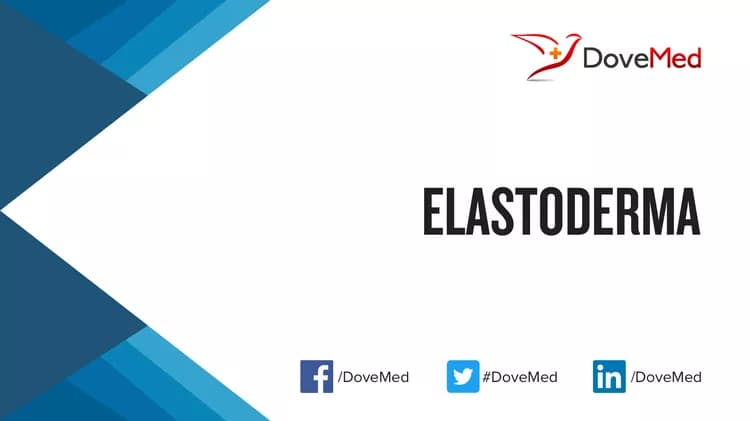What are the other Names for this Condition? (Also known as/Synonyms)
- Acquired Skin Laxity
What is Elastoderma? (Definition/Background Information)
- Elastoderma is a highly uncommon skin condition of unknown cause that results in localized patches of loose hanging skin, particularly affecting the skin in the neck and arm/leg region. Due to reduced skin laxity, the skin does not return to its original position after stretching or pinching
- It can result in complications such as secondary infections and recurrence after surgical treatments. Currently, there are no well-defined treatment measures for Elastoderma; it is generally managed symptomatically. The prognosis of individuals with this condition depends on its severity
Who gets Elastoderma? (Age and Sex Distribution)
- Elastoderma may develop sporadically in adolescents and adults
- Both males and females may be affected
- Worldwide, individuals of all racial and ethnic groups may be affected. However, the incidence of the condition is exceedingly rare
What are the Risk Factors for Elastoderma? (Predisposing Factors)
- Currently, no risk factors have been clearly identified for Elastoderma
It is important to note that having a risk factor does not mean that one will get the condition. A risk factor increases one’s chances of getting a condition compared to an individual without the risk factors. Some risk factors are more important than others.
Also, not having a risk factor does not mean that an individual will not get the condition. It is always important to discuss the effect of risk factors with your healthcare provider.
What are the Causes of Elastoderma? (Etiology)
Currently, the exact cause of formation of Elastoderma is unknown. It is reportedly an acquired cutaneous condition.
- It is believed that abnormalities in the production and synthesis of a skin protein, called elastin, may be causative. However, the reason why this occurs is not well-understood
- Elastin is a highly-elastic protein present in the connective tissues. It gives structural support to several organs and helps skin return to its original position when stretched or poked
What are the Signs and Symptoms of Elastoderma?
The signs and symptoms of Elastoderma may vary from one individual to another and may include:
- Presence of skin patches that are loose (cutis laxa) or stretchy on any region of the body
- This skin laxity may be commonly present on the neck, knees, and elbows
- Decreased skin recoil (returning to an original position)
- Red and itchy rashes
- Skin lesions may be in the form of papules (elevated skin areas that are well-circumscribed) and nodules
- Bacterial skin infection
- Premature skin wrinkling
- Increased skin sensitivity
How is Elastoderma Diagnosed?
The following tests and exams may be used in the diagnosis of Drug-Induced Dermatomyositis:
- Complete physical examination and thorough medical history evaluation
- Assessment of the presenting signs and symptoms
- Dermoscopy: It is a diagnostic tool where a dermatologist examines the skin using a special magnified lens
- Wood’s lamp examination: In this procedure, the healthcare provider examines the skin using ultraviolet light. It is performed to examine the change in skin pigmentation
- Skin biopsy: A skin tissue biopsy is performed and sent to a laboratory for a pathological examination. The pathologist examines the biopsy under a microscope. After putting together clinical findings, special studies on tissues (if needed) and with microscope findings, the pathologist arrives at a definitive diagnosis
A differential diagnosis may be necessary to eliminate other conditions that present similar signs and symptoms.
Many clinical conditions may have similar signs and symptoms. Your healthcare provider may perform additional tests to rule out other clinical conditions to arrive at a definitive diagnosis.
What are the possible Complications of Elastoderma?
The complications of Elastoderma may include:
- Low self-esteem
- Cosmetic concerns
- Skin ulceration
- Secondary bacterial and fungal infections
- Recurrence of Elastoderma following surgery to remove loose skin
Complications may occur with or without treatment, and in some cases, due to treatment also.
How is Elastoderma Treated?
Currently, there are no well-established treatments for Elastoderma. However, the healthcare provider may consider symptomatic treatment that may include:
- Adequate skin care
- Some patients may also undergo cosmetic surgery to treat the skin symptoms and improve their physical appearance
- Regular medical screening at periodic intervals with tests and physical examinations are recommended
How can Elastoderma be Prevented?
The risk factors and cause of Elastoderma are presently unknown; therefore, no guidelines or methods are available for its prevention.
What is the Prognosis of Elastoderma? (Outcomes/Resolutions)
- The prognosis of Elastoderma is dependent upon the severity of the signs and symptoms and associated complications, if any
- Although the condition may be corrected with surgical removal of loose/hanging skin, the laxity is reported to recur
Additional and Relevant Useful Information for Elastoderma:
The following DoveMed website link is a useful resource for additional information:
Related Articles
Test Your Knowledge
Asked by users
Related Centers
Related Specialties
Related Physicians
Related Procedures
Related Resources
Join DoveHubs
and connect with fellow professionals



0 Comments
Please log in to post a comment.